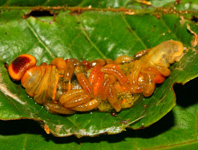Abstract
The term ‘melanism’ means the occurrence of variant(s) that is/are mostly or completely dark in pigmentation either as intraspecific polymorphisms or as fixed differences between closely related species. Melanism can refer to variation involving discrete melanic and non-melanic phenotypes (melanic and typical morphs) or to cases of continuously varying pigmentation (True 2003). Melanism of moths inhabiting areas with industrial pollution is a very well-known example involving melanic polymorphisms in insects. However, melanism is also known in other insect orders, e.g. Coleoptera and Diptera (Majerus 1998, True 2003).
References
Abbott, C.E. (1968) Inherited melanism in the Large Milkweed Bug, Oncopeltus fasciatus (Heteroptera Lygaeidae). Annals of the Entomological Society of America, 61 (2), 542.
https://doi.org/10.1093/aesa/61.2.542
Ahmad, I. & Önder, F. (1993) A review of status of Cyphostethus Fieber (Hemiptera: Acanthosomatidae) from western Palaearctic region. Pakistan Journal of Entomology Karachi, 8 (1), 55–62.
Ceballos, L.A., Piccinali, R.V., Berkunsky, I., Kitron, U. & Gürtler, R.E. (2009) First finding of melanic sylvatic Triatoma infestans (Hemiptera: Reduviidae) colonies in the Argentine Chaco. Journal of medical entomology, 46 (5), 1195–1202.
https://doi.org/10.1603/033.046.0530
Carvajal, M.A. & Faúndez, E.I. (2015) Revalidation of Ditomotarsus hyadesi Signoret, 1885 stat. rest. (Hemiptera: Heteroptera: Acanthosomatidae) with notes on its Natural History. Biodiversity and Natural History, 1 (1), 18–25.
Dias, F.B.S., Jaramillo-O, N. & Diotaiuti, L. (2014) Description and characterization of the melanic morphotype of Rhodnius nasutus Stål, 1859 (Hemiptera: Reduviidae: Triatominae). Revista da Sociedade Brasileira de Medicina Tropical, 47 (5), 637–641.
https://doi.org/10.1590/0037-8682-0007-2014
Gorczyca, J. & Herczek, A. (2002) Klucze do oznaczania owadów Polski. Część XVIII. Pluskwiaki różnoskrzydłe—Heteroptera. Zeszyt 6a. Tasznikowate—Miridae. Podrodziny: Isometopinae, Deraeocorinae. [Keys to the identification of insects of Poland. Part XVIII. True bugs— Heteroptera. Volume 6a. Plant bugs—Miridae. Subfamilies: Isometopinae, Deraeocorinae]. Polskie Towarzystwo Entomologiczne, Toruń, 31 pp. [in Polish]
Faúndez, E.I. & Osorio, G.A. (2010) New data on the biology of Sinopla perpunctatus Signoret, 1864 (Hemiptera: Heteroptera: Acanthosomatidae). Boletín de Biodiversidad de Chile, 3, 24–31.
Kumar, R. (1974) A revision of world Acanthosomatidae (Heteroptera: Pentatomidae): Keys to and descriptions of subfamilies, tribes and genera, with designation of types. Australian Journal of Zoology Supplementary Series, 22 (34), 1–60.
https://doi.org/10.1071/AJZS034
Lewis, T.M. & Horton, D.R. (2010) Orius diespeter Herring in North America: color variation and updated distribution (Hemiptera: Heteroptera: Anthocoridae). Proceedings of the Entomological Society of Washington, 112 (4), 541–554.
https://doi.org/10.4289/0013-8797.112.4.541
Lis, J.A., Lis, B. & Ziaja, D.J. (2012) Heteroptera Poloniae 2. Pentatomoidea. Część I. [Part I]. Plataspidae, Thyreocoridae, Cydnidae, Acanthosomatidae, Scutelleridae. Centrum Studiów nad Bioróżnorodnością (CeStuBio), Opole, 145 pp. [in Polish]
Majerus, M.E.N. (1998) Melanism: Evolution in Action. Oxford University Press, Oxford, New York and Tokyo, xiii + 338 pp.
Mendes, L.O.T. (1938) Genetics of Dysdercus. I. Behaviour of a melanic form of Dysdercus mendesi Bloete. The Journal of Heredity, 29 (10), 387–389.
https://doi.org/10.1093/oxfordjournals.jhered.a104417
Mohaghegh, J. (2008) Comparison of development time and reproduction of typical and melanic Eurygaster integriceps (Heteroptera: Scutelleridae) under laboratory conditions. Journal of Entomological Society of Iran, 27 (2), 109–126.
Ribes, J. & Pagola-Carte, S. (2013) Hémiptères Pentatomoidea euro-méditerranéens. Volume 2: Pentatominae (suite). Faune de France. Vol. 96. Fédération Française des Sociétés de Sciences Naturelles, Paris, 423 pp.
Schaefer, C.W. (1975) A re-assessment of North American Leptocoris (Hemiptera-Heteroptera: Rhopalidae). Annals of the Entomological Society of America, 68, 537–541.
https://doi.org/10.1093/aesa/68.3.537
Stock, M.W. (1980) Wing pigmentation in Saldula fernaldi Drake (Heteroptera: Saldidae). Journal of the Kansas Entomological Society, 53 (2), 277–286.
True, J.R. (2003) Insect melanism: the molecules matter. Trends in Ecology and Evolution, 18 (12), 640–647.


